Interested in snorkeling but not sure where to start? This guide will give you the basics of what you need to know before hitting the water. Snorkeling is a great way to explore the marine life and world beneath the seas, and it’s not as hard as you might think! Snorkeling allows you to explore marine life, coral reefs, and other under-the-water sights like shipwrecks and more. In this guide, we’ll break down everything you need to know about snorkeling gear and techniques as well as common questions like do I need to be a good swimmer to snorkel? Is snorkeling hard? How do I get water out of my snorkel? and many more. We’ll also discuss some of the things you should avoid while snorkeling. So whether you’re a beginner or an experienced swimmer, this guide has something for everyone!
What is snorkeling?
Snorkeling is a great way to explore the underwater world in a fairly simple and enjoyable way. With 71% of the earth covered in water, it unlocks huge areas of the world to explore in a fun and exciting way. All you need is a mask, snorkel, and fins it get started – we will talk about all of the equipment and options next in this guide.
What type of snorkeling equipment do I need?
Before you jump into the great blue ocean it makes sense to initially familiarize yourself with the different pieces of equipment that are needed to have an amazing day snorkeling. The most critical pieces of equipment for a snorkeler are a well-fitting mask, fins, and a snorkel. In addition to these three most important pieces of equipment, there are other items that you may want to take out on your adventure with you. These additional items include a swim or snorkeling vest, a whistle, and maybe even a dive flag for times when are not going out with a snorkel tour operator. Let’s discuss each of these items in more detail.
Mask
The mask is your window to the underwater world! The type of mask you select will alter your view. First and foremost It is important to find a mask that fits your face well because a poorly fitting mask can be very uncomfortable and will likely leak water. Typically the difference between a snorkel mask and a scuba diving mask is the materials – many snorkeling masks use acrylic lenses compared to the tempered glass used in scuba masks. Snorkeling masks are usually not built to the same quality standards, since they are not used at the extreme pressures scuba masks are. Note – in this guide we will not discuss full-face masks as there are additional items that need to be considered when using that type of mask. Key items to look out for when selecting a mask are:
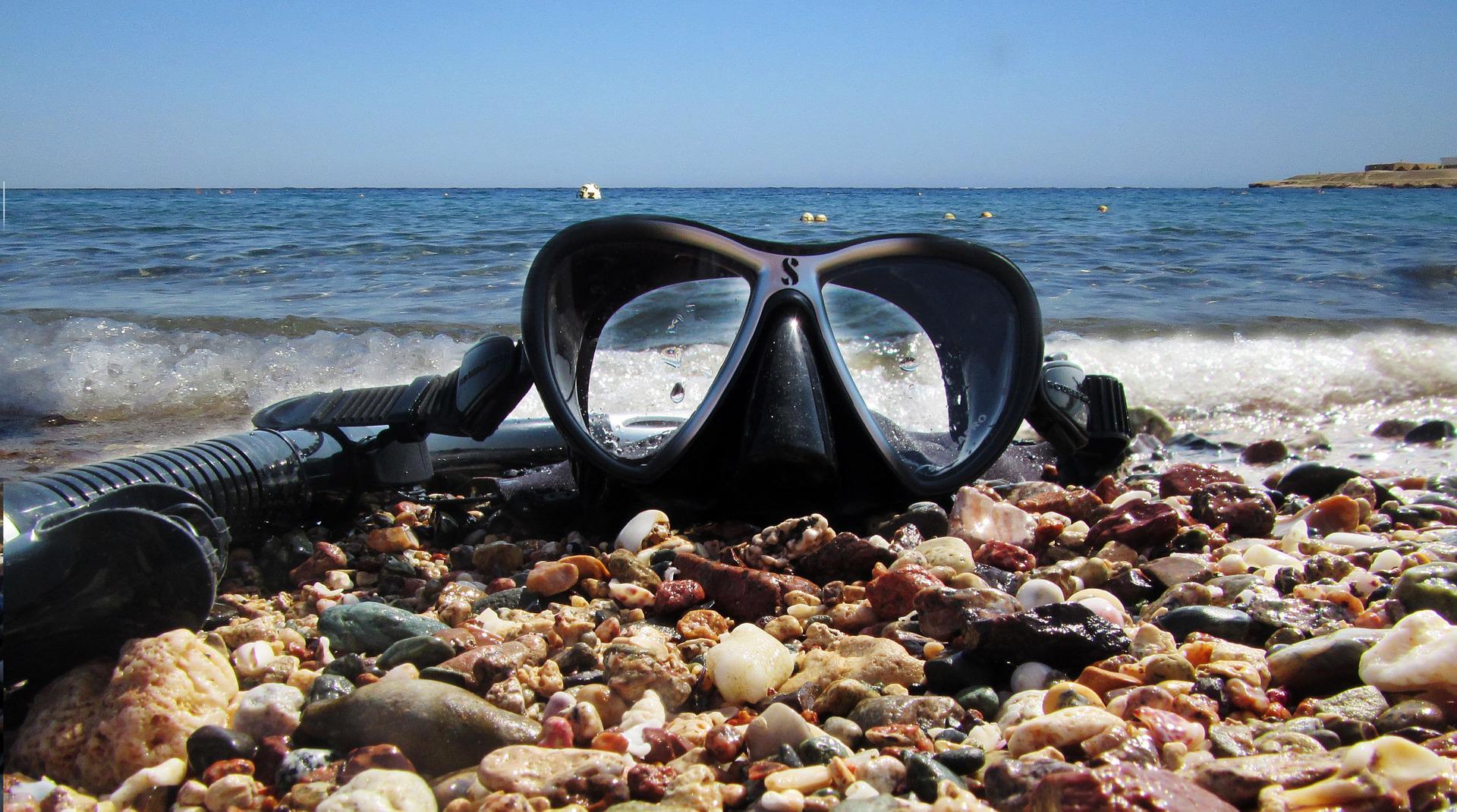
Fit
this is by far the most important aspect, don’t just pick a mask because it looks cool – your mask must fit well to seal and keep water out. How to tell if a snorkeling mask fits? Follow these quick steps:
- Hold the mask gently against your face, but don’t put the strap around your head
- bend your head back by looking up and take your hands away
- Inhale a little bit through your nose.
- now look back down and if the mask fits it will stay suctioned to your face without the need to continue to inhale.
Field of View
When selecting a mask for snorkeling test it for the field of view different masks have very low profiles that tend to make a wider field of view but can also make the mask uncomfortable. Additionally, some masks have panoramic windows that let additional light in from the sides and can aid in extending the view to your peripheral vision.
Mask Styles
There are countless mask styles however they typically fall into three main categories:
- Two-window Mask – These masks have two separate lenses and offer a wide field of view. The two-window mask design often allows the lens to be close to your face which results in a lower volume mask that can be slightly easier to clear when filled with water. They are great for snorkeling. These two window snorkel masks are pretty common and can be found in a variety of styles and configurations.
- Single Window Mask – These masks have a single continuous lens which typically results in a wide view with no obstructions this help to maintain binocular vision which helps with depth perception.
- Side Window or Panoramic Masks – These masks have either a single or double main lens with the lens extending down the side a bit which lets in additional light and can open up the field of view. Often times because of the additional windows the volume tends to be a little larger but that amount of additional light and increased field of view can offset this additional volume.
Framed vs. Frameless Masks
A frameless mask will have the glass molded directly into the skirt while the framed mask will have the glass held in a frame which is then attached to the mask skirt.
Frameless Masks: were originally manufactured for freedivers and spearfishermen
- Often better field of view due to its low profile
- larger flexible silicone skirt for better sealing resulting in a mask that is less likely to leak
- Easier mask clearing
- Less mask squeeze when descending to a depth
Framed Masks: these are the classic snorkeling and scuba masks
- More durable due to the rigid frame design
- Usually less expensive but can vary based on mask features and design
- Support the addition of prescription lenses
- Due to the rigid frame will often have better strap clips
- A longer history of manufacture and a much wider range of styles
A final item to consider with a snorkel mask is some sort of anti-fog solution, you can get this at most dive shops where you would get snorkeling equipment or you can use baby shampoo which acts as a great anti-fog solution. Just put a small drop of baby shampoo on your lens smear it around and do a quick rinse and if needed smear the remainder of the shampoo around until clear.
Snorkels
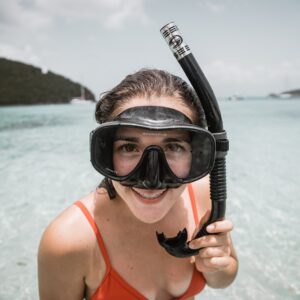 Snorkels come in a variety of shapes, sizes, and designs but they all perform the same basic function – to allow you to breathe while your face is submerged. In its most basic form, a snorkel is a J-shaped breathing tube. Most snorkels are designed to be attached to the left side of your face – this is because scuba divers usually have their regulators on their right-hand side.
Snorkels come in a variety of shapes, sizes, and designs but they all perform the same basic function – to allow you to breathe while your face is submerged. In its most basic form, a snorkel is a J-shaped breathing tube. Most snorkels are designed to be attached to the left side of your face – this is because scuba divers usually have their regulators on their right-hand side.
There are 3 standard types of snorkels that you will usually find – although there are massive variations in the designs they typically fall into three broad categories. Tube snorkels, semi-dry and dry snorkels. Learn more about the different types of snorkels.
Tube Snorkels
Tube snorkels are just that a tube, with a mouthpiece and usually some sort of clip to attach the snorkel to your mask. There are pocket snorkel variants that are made of silicone and roll up to fit in your scuba diving BCD pocket you usually won’t find snorkelers using pocket snorkels.
Semi-dry Snorkels
Semi-dry snorkels are snorkels that usually have a corrugated tube that allow you to better adjust the fit but also helps pull the snorkel mouthpiece away from your face when above the surface. Their key feature is a deep ‘well’ below the mouthpiece with a one-way check valve that serves to pool little bits of water away from the flow of air but also makes it easier to clear water from a snorkel by pushing water out of the purge valve rather than having to clear water by blowing out of the end of the tube. Additionally, most semi-dry snorkels have some sort of a wave/water deflector at the top of the tube to help deflect water from entering the tube when encountering waves.
Dry Snorkels
Dry snorkels are designed to try and limit the entry of water into the snorkel tube. This happens usually by a mechanism that floats up when submerged and closes off the end of the snorkel tube. This coupled with a wave deflector and a well with a purge valve work together to limit the amount of water entering and staying within your tube. Different styles have different levels of effectiveness at keeping out water.
Fins
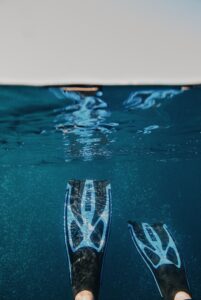 Snorkel fins come in a wide range of shapes and sizes with the two broad categories being ‘full foot’ or ‘open heel’. The main difference between these types of fins is how they attach to your feet. There are great options in both styles, but finding a well-fitting set of fins is of the greatest importance. In addition to ‘open heel’ or ‘full foot’ categories of snorkeling fins, there are also different lengths – depending on where your snorkeling adventuring is taking you you might need to consider shorter travel fins or if the water is a little more choppy opt for longer fins giving you more propulsion. The general rule is the bigger the fin, the more power you will have to move through the water – but this comes at a price. Bigger fins are often more difficult to get on and off and can be tiring to wear for long periods.
Snorkel fins come in a wide range of shapes and sizes with the two broad categories being ‘full foot’ or ‘open heel’. The main difference between these types of fins is how they attach to your feet. There are great options in both styles, but finding a well-fitting set of fins is of the greatest importance. In addition to ‘open heel’ or ‘full foot’ categories of snorkeling fins, there are also different lengths – depending on where your snorkeling adventuring is taking you you might need to consider shorter travel fins or if the water is a little more choppy opt for longer fins giving you more propulsion. The general rule is the bigger the fin, the more power you will have to move through the water – but this comes at a price. Bigger fins are often more difficult to get on and off and can be tiring to wear for long periods.
Full Foot Fins
As the name suggests full-foot fins are made to fit snugly around your whole foot like a slipper. With full foot fins, you can wear them barefoot and don’t need dive socks or booties like open heel fins may require.
Open Heel Fins
Open heel fins are designed to go over the foot similar to a shoe but with an open back that can be adjusted with a strap. These types of fins usually need some sort of dive sock or fin bootie as they will rub against your skin without something protecting your foot.
Other useful snorkel equipment
In addition to the ‘big 3’ pieces of snorkeling gear, you may want to consider these other items depending on where you will be snorkeling or your level of comfort snorkeling.
Snorkeling Vest
Many snorkeling operators will require or provide you with a swim vest. These swim vests are designed to help keep you afloat and to help make your snorkeling adventure more enjoyable. Swim vests are super easy to use and comfortable. As a result that can lower your level of exertion and help you enjoy the marine life and underwater world more.
Sun protection – Rash Guard and sunscreen
A rash guard is a shirt made of swimsuit material that helps protect your skin from the sun’s harmful rays. Because you will be in the water for long periods, it is important to have some kind of protection against the sun. A rash guard can also help prevent chafing from your snorkeling gear or swim vest.
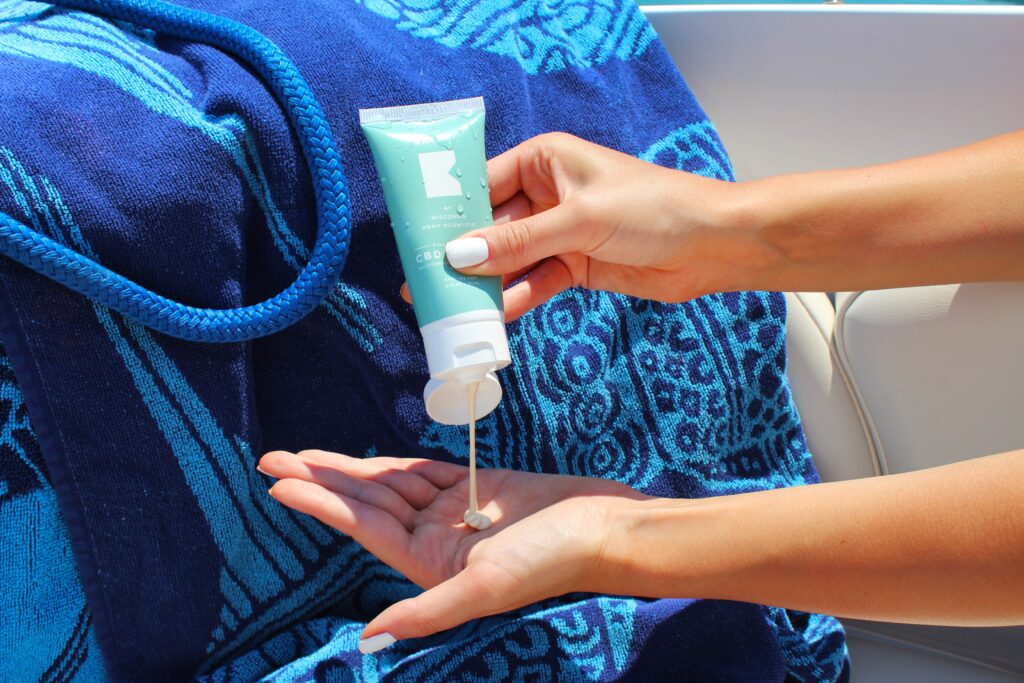 In addition to a rash guard, you will want to apply a reef-safe sunscreen. Reef-safe sunscreen is important to help protect the delicate marine life and coral reefs. Unfortunately, there is not a lot of regulation around reef-safe sunscreens so it is important to read the labels and ensure the sunscreen you are using does not contain any of the following substances
In addition to a rash guard, you will want to apply a reef-safe sunscreen. Reef-safe sunscreen is important to help protect the delicate marine life and coral reefs. Unfortunately, there is not a lot of regulation around reef-safe sunscreens so it is important to read the labels and ensure the sunscreen you are using does not contain any of the following substances
- Oxybenzone
- Octinoxate
- Octocrylene
- Homosalate
- 4-methylbenzylidene camphor
- PABA
- Parabens
- Triclosan
- Any nanoparticles or “nano-sized” zinc or titanium (if it doesn’t explicitly say “micro-sized” or “non-nano” and it can rub in, it’s probably nano-sized)
- Any form of microplastic, such as “exfoliating beads”
Whistle
A whistle is an important safety device that can help you signal for help if needed. It is most useful in busy snorkeling sites with lots of boat traffic or those remote locations where you may get separated from your snorkeling boat.
Dive Flag
If you are snorkeling in an area where there might be scuba diving boats, it is a good idea to have a dive flag. This will help alert the boat operators of your presence and help them avoid running into you. Snorkel tour operators typically have a dive flag on their vessels. But if you are snorkeling without a tour operator in an area where there may be boat traffic a dive flag is a really important piece of safety equipment
How To Snorkel
Now that we have all of the equipment talk out of the way, let’s get into how to actually snorkel. As previously noted snorkeling is relatively easy and can be done by people of all ages and swimming abilities.
If you have your own equipment we recommend you try and find a local swimming pool with shallow water and try out your equipment before heading out for your excursion. You can use your time in the pool to become a more experienced snorkeler, increase your swimming efficiency, and quickly become a more advanced snorkeler as you become more comfortable in the water.
First, let’s discuss attaching your snorkel to your mask. The snorkel should be attached to the mask about halfway down – using the clip on your snorkel. This will help keep the snorkel in place and prevent it from falling off when you are in the water.
Now that your snorkel is attached set aside your mask and start putting on your fins. Your fins should slip on easily but feel snug. Once your fins are on be careful moving around – if on a boat or in a confined space be careful not to step on others’ fins and in some cases it is easier to walk backward when wearing your fins to prevent tripping on them.
Now it’s time to put on your mask. Make sure that the seal on your mask is clean and free of any hair or debris. Once you are sure your mask seal is clear, place the mask over your eyes and nose and slip the strap over the back of your head ensuring the strap is pulled snugly but comfortably.
At this point, it is time to enter the water and enjoy your time exploring the coral and marine life
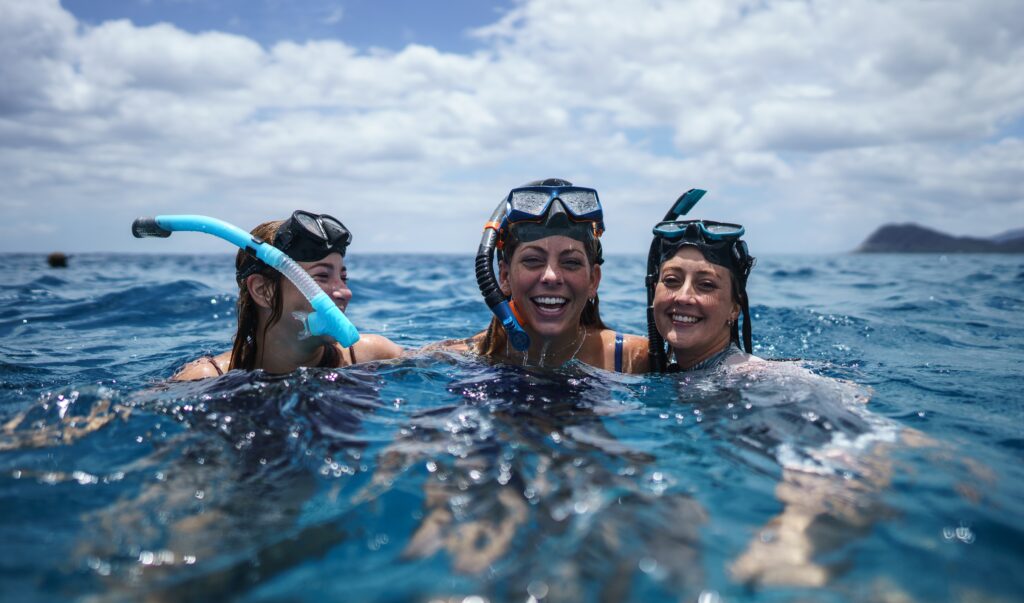
Important Snorkeling Skills to Know Before You Go Snorkelling
There is a small set of key skills to know before you jump into the water for the first time to snorkel. We will review the key skills below. If you have a good understanding of these skills then you are ready to enjoy the water and see some amazing underwater sites and other marine life.
Breathing Through Your Snorkel
It is important to breathe through your snorkel the same way you would breathe without one. Be careful not to hyperventilate. There will be occasions where you will need a deeper breath for example in cases where you are about to dive down below the surface or need to clear your mask or snorkel.
Snorkel Clearing
If you have one of the common semi-dry snorkels you can simply exhale firmly into your snorkel to push water out of the purge valve. If you have a tube-style snorkel without a purge valve you may need to exhale more forcefully to push water out of the end of the tube.
Mask Clearing
To clear your mask press gently on the top of your mask, tilt your head back, and blow out through your nose. This should push the water out of your mask.
Kicking / Finning
The more streamlined you are the easier it will be to propel yourself in the water using a flutter-style kick. You will get the best propulsion moving your legs from the hips. If you kick only from the knees you will tend to have more of a bicycle kick which is much more inefficient and will result in you tiring more quickly.
Body Position
During your snorkeling experience, you will be face down and swim slowly with a leisurely kicking pace with your hands at your side or resting on the small of your back. Keeping your arms relaxed and taking your time will allow enjoy the sights and capture amazing moments below the surface.
Advanced Snorkeling Tips
We have pulled together a few additional tips that may help you enjoy snorkeling even more by getting closer to the reef and marine animals.
Diving Down
To dive down, first start with taking a few (two or three) relaxed deep breaths. Tighten your mouth around the snorkel to ensure a good seal. While lying flat look down deeper at your snorkeling location. Drop your hands down so they are pointing down. Then bend at the waist and flick your fins up in the air to propel yourself down.
A few additional notes:
- Always make sure when you are snorkeling, especially when diving down that you have a buddy with you.
- As you dive deeper you will feel pressure on your sinus’ and ears – you can equalize this pressure by squeezing your nose and gently blowing to clear your sinus’ and ears. Note don’t blow to hard – if you can’t equalize ascend slowly.
- Ascend carefully and make sure to look up to avoid any collisions.
We hope this quick guide has helped you understand snorkeling and the basics of how to snorkel. Now it’s time to get out there and explore the amazing underwater world! Have fun and be safe!
Planning for a vacation and wondering what to bring for your next snorkeling trip? We have compiled a list of the ten most essential gears to carry for your upcoming adventure! Read this article to learn more.
Updated on: December 05, 2023

